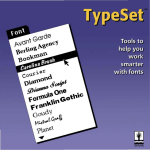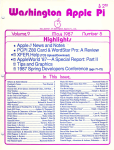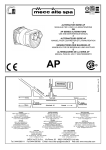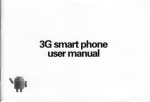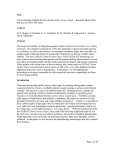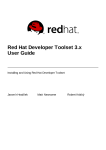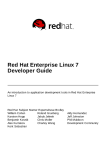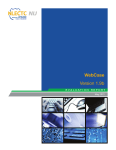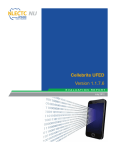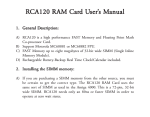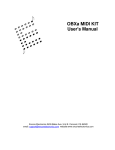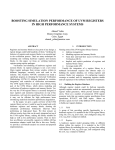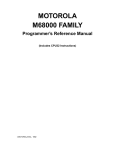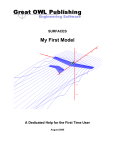Download Floating Point Engine (FPE) Owner`s Manual
Transcript
Innovative Systems
Floating Point Engine (FPE)
Owner's Manual
1989-91
\
Innovative Systems
Copyright
©Copyright 1989-91. Innovative Systems for all nontextual material, graphics, figures, photographs, and all
computer program listings or code in any form, including object and source code. All rights reserved.
Innovative Systems, the Systems People, is, Floating Point Engine, and FPE are trademarks of Innovative
Systems.
Apple, Apple II. Apple lie. Apple IIGS. IIGS, ProDOS. and Macintosh are trademarks of Apple Computer, Inc.
SANE is a trademark of Apple Computer. Inc.
AppleWorks is a trademark of Apple Computer. Inc. licensed to Claris Corp.
ORCNM. ORCNC. and ORCA/Pascal are trademarks of The Byte Works, Inc.
TML BASIC and TML Pascal are trademarks ofTML Systems. Inc.
Lisa816 Software is a copyright of Randall Hyde and HAL Labs.
Merlin 8/16 and Merlin 16+ are trademarks of Roger Wagner Publishing. Inc.
Innovative Systems
P.O. Box 444
Severn. MD 21061-0444
(301 )987 -8688n68-4599
Limited Warranty on Media and Replacement
If you discover physical defects in the manuals distributed with an Innovative Systems product or in the media
on which a sofLware product is distributed, Innovative Systems will replace the media or manuals at no charge
to you, provided you return the item to be replaced with proof of purchase to Innovative Systems or an
authorized Innovative Systems dealer during the 90-day period after you purchased the software.
ALL IMPLIED WARRANTIES ON THE MEDIA OR MANUALS, INCLUDING IMPLIED
WARRANTIES OF MERCHANTIBILITY AND FITNESS FOR A PARTICULAR PURPOSE, ARE
LIMITED IN DURATION TO NINETY (90) DAYS FROM THE DATE OF THE ORIGINAL RETAIL
PURCHASE OF THE PRODUCT.
Even though Innovative Systems has tested the software and reviewed the documentation, INNOVATIVE
SYSTEMS MAKES NO WARRANTY OR REPRESENTATION, EITHER EXPRESS OR IMPLIED,
WITH RESPECT TO SOFTWARE, ITS QUALITY, PERFORMANCE, MERCHANTIBILITY, OR
FITNESS FOR A PARTICULAR PURPOSE. AS A RESULT, THIS SOFTWARE IS SOLD "AS IS,"
AND YOU THE PURCHASER ARE ASSUMING THE ENTIRE RISK AS TO ITS QUALITY AND
PERFORMANCE.
IN NO EVENT WILL INNOVATIVE SYSTEMS BE LIABLE FOR DIRECT, INDIRECT, SPECIAL,
INCIDENT AL, OR CONSEQUENTIAL DAMAGES RESULTING FROM ANY DEFECT IN THE
SOFTWARE OR ITS DOCUMENTATION, even if advised of the possibility of such damages. In
particular, Innovative Systems shall have no liability for any programs or data stored or used with Innovative
Systems products, including the costs of recovering such programs or data.
THE WARRANTY AND REMEDIES SET FORTH ABOVE ARE EXCLUSIVE AND IN LIEU OF ALL
OTHERS, ORAL OR WRITTEN, EXPRESS OR IMPLIED. No Innovative Systems dealer, agent, or
employee is authorized to make any modification, extension, or addition to this warranty.
Some states do not allow the exclusion or limitation of implied warranties or liability for incidental or
consequential damages, so the above limitation or exclusion may not apply to you. This warranty gives you
specific legal rights, and you may also have other rights which vary from state to state.
Innovative Systems
Warning
Innovative Systems provides a Hoating Point Engine card that is for installation in your personal computer.
Thus, the FPE is classified as a subassembly by the FCC. See instructions if interference to radio or television
reception is suspected~
Information to Users
This floating point card generates and uses radio frequency energy and if not installed and used properly - that
is, in strict accordance with the manufacturer's instructions - may cause interference to radio and television
receptions.
Instructions
If this card does cause interference to radio or television reception - which can be determined by turning the
equipment on and off and noting the effect of the power surge on the radio or television - you are encouraged to
try to correct the interference by one or more of the following measures:
• Reorient the receiving antenna.
• Move the computer away from the receive.
• Plug the computer into a different outlet SO that the computer and receiver are on different branch
circuits.
If necessary you should consult with Innovative Systems or an experienced radio/television technician for
additional suggestions. You may find the following booklet prepared by the FCC helpful: "How to Identify and
Resolve Radio-TV Interference Problems." This booklet is available from the U.S. Government Printing
Office, Washington, D.C., 20403, Stock No. 004-000-00345.4.
LIMITED WARRANTY
Innovative Systems warrants all of its hardware products, including spare parts sold by Innovative Systems, to
be free from defects in material and workmanship for a period of five years from the date of delivery.
This warranty is made to original purchasers only, and only original purchasers make make any claim under the
warranty. No other party shall have any rights under this warranty. The sole remedy for any breach of this
warranty shall be the repair or replacement of the defective product, as described herein.
Innovative Systems disclaims all other representations and warranties, included but not limited to, any implied
warranty of merchantibility or fitness for a particular purpose. Innovative Systems shall not be liable for any
special, indirect, incidental or consequential damages, lost profits, costs or expenses, except as set forth in this
policy, which may be modified or amended only by written contract
In-Warranty Repair
Innovative Systems will repair at its factory or repair center, any product that within the warranty period is
returned to Innovative Systems and found to be defective in proper usage.
Innovative Systems will honor the warranty if notification of product failure is provided within the five year
warranty period. The original customer must return the defective product to Innovative Systems. One-way
transportation charges are at the customer's expense. Innovative Systems will return the repaired or replaced
product at the expense of Innovative Systems.
Innovative Systems reserves the right to reject any warranty claim on any products that have been the subject of
abuse, misuse, unauthorized repair, alteration, accident, improper return handling or causes external to the
Innovative Systems
product but not limited to: improper power application, improper environmental exposure or other improper use
of the product.
Innovative Systems includes in its Limited Warranty policy, provisions for updating in accordance with any
field change order which Innovative Systems detennines is mandatory for reasons of product safety. All other
field changes, revisions or updates not deemed mandatory by Innovative Systems may be implemented at the
discretion of Innovative Systems or as required by contract.
Out-or-Warranty Repair
Innovative Systems will provide repair or replacement services for all products manufactured by or for
Innovative Systems and sold by Innovative Systems for a reasonable active product support period extending
beyond last date of standard manufacture and sale. This period will nonnally be for a period of two years from
Innovative Systems standard product list. but such period may be decreased at Innovative Systems' sole option.
Out-of-warranty products and customer-related damage of in-warranty products will be repaired or replaced in
accordance with Innovative Systems' then-current active product repair price schedule. The customer is
obligated for freight and handling charges both ways.
Below are the prices for Out-of-Warranty products manufactured or sold by Innovative Systems. The prices are
effective 1 June 1988 and are subject to change without notice.
FPE
$25.00 plus 10.00
Shipping, Handling and Processing Charges.
Our rate does not include parts.
Repair Warranty
Innovative Systems warrants any product repaired in its factory or repair center to be free from defects in
material and workmanship for a period of ninety (90) days from the date of return delivery or the end of the
original warranty period, whichever is greater.
Warranty Registration
Please ta1ce a moment to fill out the warranty registration fonn within ten days and mail it to the following
address:
Innovative Systems
P.O. Box 444
Severn, Maryland 21144-0444
Attn: Customer Service
Innovative Systems
TABLE OF CONTENTS
1. Introducing the Floating Point Engine .................................................................................................... 1
2. Installing the FPE ...........................................................................................................................;........ 2
2.2. Software ............................................................................................................................................... 2
2.3. Slot Enabling on the Apple IIGS ......................................................................................................... 3
2.4. Slot Enabling on the Apple II. II+. and /Ie ........................................................................................... 3
3. Access to the FPE ........................................................................... ;....................................................... 4
4. Interfacing to SANE. ............................................................................................................................... 6
4.1 Apple IIGS ............................................................................................................................................ 6
4.2 Apple II. II+. and 11e. ............................................................................................................................. 6
4.3 AppleWorksTM Classic .......................................................................................................................... 6
4.2 AppleWorks™ GS ................................................................................................................................ 6
5. How the FPE Transfers Data .................................................................................................................. 7
5.1 MEMREG and REGMEM Operations ................................................................................................. 7
5.2 REGREG Operations ............................................................................................................................ 8
5.3 Checking Status..................................................................................................................................... 9
6. Construction of an MC68881/MC68882 Command ............................................................................... 11
7. Macro Usage ........................................................................................................................................... 15
8. About the MC68881 and SANE ............................................................................................................. 17
9. Programming Hints ................................................................................................................................. 19
10. FPE Data and Register Fonnats ............................................................................................................ 20
Innovative Systems
Page i
1. Introducing the Rooting Point Engine™
The Innovative Systems™ (iSTM) Floating Point Engine™ (FPETM) provides the most efficient floating point
math capability for all members of the Apple IITM family. Based on the Motorola MC68881 floating point
processor, the FPE brings a new dimension in computing power to the Apple II. The MC68881 is the same
floating point processor used with the Motorola 68000 microprocessor. Although you may need not be
concerned with specific capabilities of the FPE, software and programmers have access to:
• Eight general purpose, 80-bit floating-point data registers.
• Forty-six instructions, including 35 arithmetic operations.
• Full ANSI-IEEE 754-1985 floating point standard.
• Enhanced functions, including a complete set of trigonometric and transcendental functions.
• Seven data formats: byte. word. and long word integers; single. double. and extended precision real
numbers; and packed binary coded decimal string real numbers.
• Twenty-two constants including pi. e. and powers of 10.
• Concurrent instruction execution with the Apple II.
The FPE may be called in several ways. If the system software automatically loads all tools from your disk.
then the FPE is directly callable from the Apple IIGSTM Standard Apple Numerics Environment (SANETM)
toolset. You need only boot the FPETOOLS disk 10 install the FPE software called FPETOOL.INIT onlO your
system disk in the /SYSTEM/SYSTEM.SETUP direclOry. All calls intended for SANE automatically call the
FPE once the system is rebooted from a complete shutdown. Thus, the FPE is transparent 10 you, except in
terms of speed improvement. This technique works only with the GS series.
For those users who have Apple II. 11+. or lie computers. the FPETOOLS disk contains a version of 8-bit SANE
which addresses the FPE. This version of SANE replaces all calls except those calls to the Scanner and
Formatter operations (FPSTR2DEC. FCSTR2DEC, and FDEC2STR). For fwther information, refer to Section
4.2.
For higher performance the FPE may be directly addressed through software by writing directly to the command
or reading directly from the status registers, as appropriate, in normal slot space ($COnx, where n=8 plus the slot
number). This technique works equally well with any Apple II. DOS 3.2, DOS 3.3. ProooS 8™, ProDOS 16.
and GS/OSTM without the overhead of using a toolset Please refer to Chapters 3 and 5.
The FPE is also compatible with all versions of AppleWorks Classic. You need only boot the FPETOOLS
installation disk to install FPE software software patches 10 AppleWorks. These patches will provide a
significant improvement in the calculation and recalculation time required by the spreadsheet and some database
operations.
This manual describes how to communicate with the Innovative Systems FPE. It does not explain the inner
workings of the Motorola MC68881 floating point coprocessor. Refer to the Motorola "MC68881/MC68882
Floating Point Coprocessor User's Manual", and related application notes. for details on how to use the
MC68881. These items are available from Motorola or. for a nominal charge, from Innovative Systems.
This manual is written to address different levels of users. If you do not plan 10 write your own code, you need
to read Chapters 1 and 2 only. If you intend to address the FPE using your own code, you will also need to read
and 10 understand Chapters 3 through 10.
Innovative Systems
Page 1
2. Installing the FPE.
Installation consists of three parts: hardware, software and slot enabling.
Hardware installation consists of plugging the FPE into an expansion slot in the Apple II. This means that you
may use any slot numbered between 1 and 7. Don't try to use the memory expansion slot in the IIGS-it is not a
peripheral slot. The slot you choose will be dictated by the slots you have available.
Note that there are only two ways you can damage the board during installation - static electricity and putting
the board in backwards. If you carefully observe the following instructions, neither will be a problem:
1. Ensure all power to your computer is orr by removing tbe power cord from tbe wall outlet.
2. Carefully remove the case cover from your computer as described in the owner's manual supplied by
Apple.
3. Face the computer as you nonnally would if using it (keyboard toward you. Refer to Figure 2-1.).
POWER
SUPPLY
4. Ground yourself by touching the top
of the metal cover of the power
supply on the left hand side of the
computer.
~~~~~~~~
Component
Side of FPE
I-
KEYBOARD
III i
FIGURE 2-1 FPE Installation
5. Remove the FPE from the box and the
anti-static plastic wrapping.
6 Plug the FPE into the slot of your
choice, ensuring that the component
side of the board (the side with the
lettering) faces to your right, away
from the power supply.
7. Replace the case cover, plug the
computer power cord into the power
outlet, apply power, and boot your
computer as normal.
8. The computer should boot nonnally.
9. The computer is now ready for software installation.
2.2. Software
Software installation requires booting the FPETOOLS distribution disk. The software on this this disk will
move certain files from the is installation disk to your system disk.
1. Enable the slot if you have a IIGS and the slot requires enabling to use "YOUR CARD" (see Slot
Enabling). Then power down the computer.
2. Boot the FPETOOLS installation disk. The disk will automatically locate the FPE and report the slot
number to you.
3. Select option 3 from the Installation Menu. This test will verify that the FPE functions correctly.
NOTE:
Innovative Systems
Page 2
1. If the installation software reports an error or your system hangs, verify that you
have installed the FPE correctly (power down your system fIrst, then reboot) and
verify that you have enabled the slot (set it to "Your Card,,), if you have an Apple
IIGS. If the rerunning the test returns an error or your system hangs, please contact
Innovative Systems for technical suppon.
2. If the test does not return (the system hangs) and you have an Applied Engineering
TransWarp GS1loI, you will need to contact AE to obtain a modification to the
TWGS. Contact AE customer support for more infonnation.
4. If you have a IIGS. select option 1 too install the FPE Toolset on your system disk(s). Note that if
your system disk is named "!hardI", for example, the disk name you should enter when requested is
"!hard 1". No directory infonnation is required. After successful installation, all SANE calls
(TOOLOIO or $xxxA) will then automatically access the FPE without any need to recompile,
reconfIgure. or replace any of your existing commercial or user-written software that uses the
SANE Toolset
5. If you have AppleWorks Classic, select option 2 to install a patch which provides the capability for
AppleWorks to use the FPE when doing math. Because AppleWorks can be in a subdirectory,
please provide the volume name and the subdirectory in response to the prompt from the
initialization program. For example, if AppleWorks is located in directory "/AppleWorks" on
volume "!hardl", please enter "!hardl/AppleWorks" when prompted. Also, if your Startup disk and
your Program disk are the same, enter the same infonnation after both prompts.
6. Select option 0 to exit the installation program.
Innovative Systems has provided a FPE toolset initialization me, coded specifIcally for each slot. These slot
dependent files provide a small speed improvement over mes which automatically locate the FPE slot, because
the code uses direct addressing of the FPE slots rather than using indirect indexed addressing. Thus, if the FPE
is in slot 2, you must have the me "FPETOOL.INIT.S2" in your "/SYSTEM/SYSTEM.SElUP" directory on
your startup disk.
NOTE: USE OF ANY FPETOOL.INIT FILE NOT CORRESPONDING TO THE SLOT
NUMBER CONTAINING TIlE FPE WILL CRASH YOUR SYSTEM.
Optimized code for accessing the FPE from a higher level language will be included in the particular software
package you purchase (such as ORCNC) and requires no installation on your part.
The is FPETOOLS installation disk also includes sets of macros (M8.FPE and MI6.FPE), defInitions (E8.FPE
and EI6.FPE), and some examples for various development packages (APW, ORCAIM, MERLIN 8/16,
MERLIN 16+, LlSA816) for those who wish to write their own code. Separate macro libraries are provided for
the 6502/65C02 and 65816 microprocessors. The user should use the macro library appropriate for his
computer. These files may reside anywhere on the user's disk. The macros are included in the folders
"FPE.IIGS" and "FPE.6502" on the installation disk.
2.3. Slot Enabling on the Apple IIGS
You may have to enable the slot in which the FPE is installed. Follow the instructions in your user's manual to
use the control panel to select "Your Card" for the appropriate slot. If you install the FPE in slot 3
(recommended), you do not need to enable the slot as it is always properly enabled.
2.4. Slot Enabling on the Apple II, 11+. and /Ie
No enabling is required for Apple II, 11+. or /Ie computers because the slot I/O is normally active.
Innovative Systems
Page 3
3. Access to the FPE
How does the System know which slots contains the FPE?
1. If you have an Apple IIGS and you have loaded the FPETOOL.INIT file corresponding to the slot
containing the FPE, all calls to SANE will automatically go to the FPE.
2. If you write your own code to directly access the FPE, you must use the correct address for me slot
locations: that is,
$c080 + 16*slot_nurnber (e.g., $c090 for slot I).
Refer to Chapter 9 for information on how to determine the FPE slot number without hard coding
the slot number into your code.
Direct access means that software writes information directly to or reads data directly from the FPE
coprocessor interface registers. These interface registers reside in the 16 locations reserved for the slot in which
the card resides. These 16 locations are designated as Read-only, Write-only, or Read/Write, depending upon
their purpose. In using direct access, the software does not need to "pass through" unnecessary general purpose
code.
Direct access is the most efficient method of communicating with the FPE. It eliminates overhead; this is not to
say it is always the best method of interfacing, however. Direct access programming requires a strong
understanding of programming. Chapters 5 and 6 contain additional information necessary to do direct
accessing of the FPE.
The Motorola MC68881 communicates with the host processor (6502, 65C02, or 65816) by way of Coprocessor
Interface Registers (CIR). These registers are used for control of, transferring operands to, and returning staws
from the MC68881. The Apple II technical manuals and the Motorola "MC68881/68882 Floating-Point
Coprocessor User's Manual" contain valuable information on accessing the registers and details which explain
the uses for the CIRs. The is FPE allows access to all the CIRs that are required to implement all MC68881
instructions. The only CIRs not accessible are those intended for use with the 68020/68030 microprocessors,
and which do not impact performance with the 6502/65816. The registers implemented in the FPE and their
base addresses are given in Table 3-1.
Innovative Systems
Page 4
Table 3-1: Coprocessor Interface Register (CIR) Memory Map
Base Address
Register
Response
Control
Save
Restore
Command
Condition
Operand
Location
seOkO
seOk2
seOk4
seOk6
seOk8
seOkA
seOkC
Width
16
16
16
16
16
16
32
Tj'pe
R
W
R
RIW
W
W
RIW
l. All transfers are byte swapped from normal 6502/65816 storage; that is, the MSB of the data is
contained in the lowest memory address.
2. k is the number of the slot containing the FPE + 8.
3. Word transfers (16 bits) to the Operand register use addresses SCOkC and SCOkD. Multiple
word transfers (32, 64, 80, and 96 bits) use all four locations (SCOkC-SCOkF). Note that for
80-bit transfers, the first data transfer requires that SCOkE and SCOkF receive SO values and
that bits 65 10 80 are transferred 10 SCOkC and SCOleD.
4. All locations are located in the I/O page (SOO or SE1) of 65816 RAM space.
5. All locations are in page SCO of the 6502 RAM space.
Remember that the register addresses are base addresses; so the address for a specific slot is specified by
replacing the k in the base address with 8 + slot number. For example, if the FPE is in slot 3, the Response
register starts at $CObO. Additional information on peripheral card addressing is available in Chapter 6,
"Programming for Peripheral Cards", pages 129-131 and 136-137 of the "Apple lIe Technical Reference
Manual."
Innovative Systems
PageS
4. Interfacing to SANE
The Standard Apple Numerics Environment™ (SANE) defines a series of calls which provide numeric
operations in accordance with IEEE Standard 754 Binary Floating-Point Arithmetic. SANE also provides
several utility functions which include conversions of data from an ASCII representation to binary floating point
and back again. This environment provides very accurate numerics. Unfortunately, SANE operations can be
very slow. The is FPE provides the numeric operations, but at a much faster rate.
Because SANE is standard with the Apple II computer, Innovative Systems provides numerics software
package which replaces most of the routines in the SANE toolset The software uses the same calling
sequences, processes the commands in 80-bit precision, and generally provides the same results as those
described in the "Apple Numerics Manual", available from your Apple dealer. One difference is that the
transcendentals returned are slightly less accurate (76 bits or more of accuracy versus 80 bits from SANE);
however, this change in accuracy should not adversely affect the performance of your software (see" Apple
Numerics Manual. Second Edition". Chapters 28. and Chapter 10 of this manual for the details). Another
difference is that the FPE does not process COMP type variables; however. COMP calls will work with the FPE
toolset (except at the speed of the Apple II since the calls use the standard SANE code). Because the FPE
toolset is a hybrid of calls to the FPE and to the standard SANE toolset code. use of the FPE toolset is automatic
and transparent to most existing software.
4.1 Apple IIGS
To use the is numerics software on an Apple IIGS. your must have copied the FPE.INIT from the is source disk
to the ISYSTEM/SYSTEM.SETUP subdirectory on the system disk. This is normally done by the FPETOOLS
distribution disk.
4.2 Apple II, II+. and lie
The replacement for the SANE interface in the Apple II.ll+. or lie is customized (to a specific absolute memory
address) and is included on the FPETOOLS distribution disk in the "/FPETOOLS/FPE.6502(I'OOLSET"
directory. This toolset uses the following calls:
jsr
jsr
$2100
$2104
to call the fp6502 routines
to call the ELEMS6502 routines.
This toolset loads into locations beginning at $(00)2100 and has a length of less than $1000 bytes. The toolset
has a filetype of BIN.
For more infonnation. please refer to the "Apple Numerics Manual" available from Addison-Wesley Publishing
Company. Inc.
4.3 AppleWorksTM Classic
The replacement for the AppleWorks Classic calls to the 8-bit SANE software is included on the FPETOOLS
distribution disk.
4.2 AppleWorksTM GS
Support for AppleWorks GS is automatically provided as this package uses the GS/OS and ProDOS 16 SANE
tool set calls.
Innovative Systems
Page 6
,....
5. How the FPE Transfers Data
The Innovative Systems FPE fully suppons Motorola's MC68881 coprocessor dialog. The dialog consists of a
rigidly structured combination of commands and response primitives. The commands tell the MC68881 what to
do, and the primitives indicate actions that are required, including: transfer data, wait for synchronization, wait
for completion of operation, and handle error conditions. Failure to follow the coprocessor protocol can result
in destruction of your code during program execution.
The FPE allows three types of operations: Memory-to-Register (MEMREG). Register-to-Memory
(REGMEM), and Register-to-Register (REGREG). MEMREG and REGMEM operations may be done at any
precision. REGREG operations are always done in extended precision.
5.1 MEMREG and REGMEM Operations
MEMREG and REGMEM operations move data from Apple memory to a MC68881 floating point, conlrol, or
status register, and from a MC68881 floating point, conlrOl, or status register to Apple memory (refer to the
flow charts in Figures 5-1 and 5-2). These operations are often called move-in or move-out operations.
respectively. They require that the software
1. Write a command word (16 bits) to the Command register ($COk8)
2. Check the word in the Response register ($COkO) for a Null Come-Again (CA) (any value other than
($8900)
3. Transfer the operand byte(s) to or from the Operand register ($COkC)
4. Check the word in the Response register ($COkO) for a Null Release (i.e., the most significant bit
(CA bit) is equal to 0)
The $8000 and $8900 signify that the values are written the way the MC68881 expects to write them; however,
the 6502/65816 must read and write all data in byte reversed order ($0089 in this case). The reason for the byte
reversal is that the 6502 and the 65816 write the low byte of the accumulator to the low byte of memory or to a
peripheral slot. This is opposite to the requirements of the MC68xxx series. Hence, the 68881 expects or
reports the most significant byte (MSB) as the low address byte. You must transpose the byte order of all data
(including 80 bit data) to satisfy the MC68881. Remember this because it applies to every command or operand
ttansfer to, and operand and response transfer from, the FPE.
Innovative Systems
Page 7
WRITE COMMAND
REGISTER
WRITE COMMAND
REGISTER
NULL COME-AGAIN
NULL COME-AGAIN
($8900)
($8900)
NULL ( <> $8900)
NULL ( () $8900 )
TRANSFER DA TA
TRANSFER OAT A
READ OPERAND
REGISTER
WRITE OPERAND
REGISTER
NO NULL COME-AGAIN
NO NULL COME-AGAIN
(CA BIT
3
(CA BIT - 1)
1)
PROCESSOR RELEASED
FIGURE 5-1. MOVE- IN SEQUENCE (MEMREG)
PROCESSOR RELEASED
FIGURE 5-2. MOVE-OUT SEQUENCE (REGMEM)
You might even be wondering why we check for a value of $8900. The answer is adaption. If the MC68881
was being used with an MC68020 microprocessor, the value read from the Response register would indicate the
number of bytes to be transferred. In FPE applications, the MC68881 does the same, but the 6502165816 cannot
easily make sense of this value. So to improve processing time, Innovative Systems noted that $8900 is the
only response primitive that requires the 6502/65816 to wait before transferring data. Any other value from the
Response register of the is FPE implementation indicates that the 6502/65816 may transfer an operand.
Warning: don't try to test for a non-$8900 value as this will confuse the MC68881 and destroy any data in the
FPE.
5.2 REGREG Operations
REGREG operations are used for operations that do not require operand data from memory to register transfers
(refer to Figure 5-3). Examples include adding two registers (both registers having a data value), taking the sine
of a value in a register. or even transferring a constant value from the ROM internal to the MC68881 to a
register. The sequence of operations is:
Innovative Systems
Page 8
1. Write the command to the Command
register (SCOk8)
WRITE COMMAND
REGISTER
2. Check the Response register for a Null
Release (SCOkO)
NO NULL RELEASE
NULL RELEASE
(CA BIT· 0)
PROCESSOR RELEASED
FIGURE 5-3. REGISTER/REGISTER SEQUENCE (REGREG)
Since there are no external operands, a REGREG
operation does not require that the software test for a
Null Response in the Response register as the
MEMREG and REGMEM operations do. Once it has
written the command to the Command register (with
correct byte order), the software need only test the
Response register
for the Null Release.
NOTE: Don't try to test for a non-$8900
value as this will confuse the MC68881 and
destroy any data in the FPE.
5.3 Checking Status
Example code segments for checking the status from the FPE are as follows:
65816 Version
loop 1
loop2
Idy
lda
#response
[<mc68881],y
cmp
beq
#$0089
loop I
Idy
lda
and
bne
#response
[<mc6888Il,y
#$0080
loop2
Idy
lda
#response
(mc68881),y
assumes the location containing
the base address of the FPE is
in the direct page
check for Null Come-Again
check for Null Release
6502 Version
loop I
check for Null Come-Again
(location containing
the base address of the FPE is
somewhere in memory,
location designated by
mc68881)
tax
iny
Ida
bne
cpx
beq
(mc68881),y
continue
#$89
loop I
continue
Innovative Systems
Page 9
loop2
ldy
Ida
iny
Ida
asl
bcs
Innovative Systems
#response
(mc68881).y
(mc68881).y
a
loop2
check for Null Release
always must read upper byte
Page 10
6. Construction of an MC68881IMC68882 Command
Each command written directly to the floating point coprocessor Command register requires 16 bits of
information. The format for the command (as seen by the MC6888I) is:
MSB
15
14
0
RIM
I
I
13
0
I
I
TIB
12
S
I
I S
11
I 10 I 9
I S I 0
I
I
8
0
I
I
7
0
I
I
6
0
I
I
5
0
I
I
4
C
I 3 I 2 I 1
I C I C I C
0
C
where [RIM] Field - Specifies the source operand address mode.
0- The operation is register to register.
1 - The operation is memory to register or register
to memory.
[SSS] (Source Specifier Field) - Specifies the source
register or data format.
If RIM =O. specifies the source floating point
data register. FPm.
If RIM = 1. specifies the source data format:
000 L Long Word Integer (32-bits)
001 S Single Precision Real (32-bits)
010 X Extended Precision Real (96-bits)1
011 P Packed Decimal Real (96-bits)2
100 W Word Integer (16-bits)
101 0 Double Precision Real (64-bits)
110 B Byte Integer (8-bits)
[DOD] (Destination Register) - Specifies the destination
floating point register. FPn.
[CCCCC] (Execution Command) - Specifies the operation to
perform.
NOTE
1. Only 80 bits contain valid data. but 96 bits must be transferred.
2. Only 84 bilS contain valid data. but 96 bilS must be transferred.
3. See "MC68881IMC68882 Floating-Point Coprocessor User's Manual", pages 3-1,3-2, and
3-7 for format information)
4. All operations which input data to the FPE transfer information from the source (SSS or
memory) to the destination register (DOD). This means that the source value is moved (e.g .•
added) to the destination register.
5. All register-to-register operations move data from the source register to the destination
register (e.g .• the source register is added to the contents of the destination register).
The files EI6.FPE and ES.FPE contain definitions for the RIM and Source Specifier fields, the Destination
Register field. and the Execution Command field. To define a command to add an extended real number to
register 1 do the following:
1. Get the Memory-to-Register Extended Precision value from the definitions table (Table 6.1-1)
2. Get the value for Floating Point Register 1 from Table 6.1-2 (%001). Put this value into the
Destination register field (DOD, bits 7-9). The command word should now be $4880.
3. Put the value for the command (FADD in Table 6.1-3) into bits 0-4. From the definition me, FADD
equals $22. The command word should now be $48A2. Remember that the word is in reverse
order as seen from the Apple computer. so reverse the data bytes. The value for the command is.
therefore. $A24S.
Similarly, a register 1 (SSS value) to register 2 (DOD value) add would have a final command value of
''%0010001000000101'' or $2205 in Apple memory.
Innovative Systems
Page 11
NOTE
1. To make this process easier. is has supplied macro files which will generate the most used
commands for you.
2. The 16-bit binary values for commands are given in non-Apple memory order in the
examples associated with Tables 6.1-3 and 6.14.
Table 6.1-1 MC68881 Command Primitives
Register-to-Memory Movement
$6400
Single Precision
$6000
Long Integer
$7000
Word Integer
$7800
Byte Integer
$7400
Double Precision
$6800
Extended Precision
$6c00·
Packed BCD
Memory-to-Register Movement
$4400
Single Precision
$4000
Long Integer
$5000
Word Integer
$5800
Byte Integer
$5400
Double Precision
$4800
Extended Precision
$4cOO
Packed BCD
Register-to-Register Movement
Extended Precision (only)
$0000
Constant in ROM-to-Register Movement (see Table 6.14)
Extended Precision (only)
$ScOO
Memory-to-Control. Status or Instruction Register
Long Integer (only)
$0000
Control. Status or Instruction Register-to-Memory
Long Integer (only)
$2000
* The retrieval of a packed BCD value form the FPE requires a formatting value (Iefactor). The k-factor format is as follows (encoded twos complement integer (3-bits
in locations 3-5»:
-64 to 0 - indicates the of significant digits to the right of the decimal point
(FORTRAN F format)
+ 1 to +17 - indicates the number of significant digits in the mantissa
(FORTRAN E format)
+ 17 to +63 - treated as + 17
Innovative Systems
Page 12
Table 6.1-2 Register Values
%000
Floating Point Register 0
Floating Point Register 1
Floating Point Register 2
Floating Point Register 3
Floating Point Register 4
Floating Point Register 5
Floating Point Register 6
Floating Point Register 7
Control Register
Status Register
Instruction Address
%001
%010
%011
%100
%101
%110
%111
$9000
$8800
$8400
Table 6.1.-3 Operations Values
FMOVE
FINT
FSINH
FSQRT
FLOGNPI
FETOXMl
FrANH
FATAN
FASIN
FATANH
FSIN
FrAN
FETOX
FIWOTOX
FTENTOX
FLOGN
FLOG 10
FLOG2
FABS
FCOSH
FNEG
FACOS
FCOS
FGETEXP
FGETMAN
FDIV
FMOD
FADD
FMUL
FSGLDIV
FREM
FSCALE
FSGLMUL
FSUB
FCMP
FTST
FSINCOS
$00
$01
$02
$04
$06
$08
$09
$Oa
SOc
$Od
$Oe
$Of
$10
$11
$12
$14
$15
$16
$18
$19
$Ia
$Ic
$Id
$Ie
$lf
$20
$21
$22
$23
$24
$25
$26
$27
$28
$38
$3a
$30
Move
Integer Part
Hyperbolic sine
Square Root
LOGe(1+X)
«e**X)-I)
Hyperbolic tangent
Arctangent
Arcsine
Hyperbolic arctangent
Sine
Tangent
e**X
2**X
lO**X
Natural log
Log base 10
Binary log
Absolute Value
Hyperbolic cosine
Negate
Arccosine
Cosine
Get exponent
Get mantissa
Divide
Modulo Remainder
Add
Multiply
Single precision divide
IEEE Remainder
Scale exponent
Single precision multiply
Subtract
Compare SSS with DOD
Test
Simultaneous sine and cosine·
*FSINCOS requires three registers. one source and two destination. and is a registerto-register operation only. The fonn for this command is:
Innovative Systems
Page 13
%OOSSSDDDOOOOddd + operation
ddd =destination 2 register (cosine value)
DDD =destination 1 register (sine value)
SSS source register
where:
=
Table 6.1·4 Constant in ROM-la·Register Values
SOO
SOb
$Oc
SOd
sOe
$OC
$30
$32
$33
$34
$35
$36
$37
$38
$39
$3a
$3b
$3c
$3d
$3e
$3C
PI
LOG 10(2)
e
LOG2(e)
LOGIO(e)
0.0
LOGn(2)
10**0
10**1
10**2
10**4
10**8
10**16
10**32
10**64
10**128
10**256
10**512
10**1024
10**2048
10**$4096
uses form: %0101l1DDDOOvvvvv
where:
Innovative Systems
DOD =destination
vvvvv =ROM value.
Page 14
(
7. Macro Usage
The is FPE comes with macro library files. These files are compatible with the APW, ORCNM, LISA816, and
MERLIN assemblers. M16.FPE, in conjunction with the E16.EQU file, (for LISA816 use only M16.68881)
contains macros for use with the 65816 microprocessor in the Apple IIGS. M8.FPE contains the macros for the
6502-based Apple computers. These macros are assembler specific and are contained in folders labeled for the
appropriate assembler.
The macros define the command for each operation desired. You just need to supply the operation wanted, the
address of the correctly formatted data, and the register(s) to use. These macros will load or retrieve the results
of the operation. The general format of the macros is as follows:
APW/ORCA/LISA816 Assembly
Memory-to-Register:
MEMREGv
OPERATION_CODE,DESTINATION_FP_REGISTER,DAT A_ADDRESS
where v precision of operation (X, D, S, L, W)
=
Register-to-Memory:
OPERATION_CODE,SOURCE_FP_REGISTER,DATA_ADDRESS
REGMEMv
where v =precision of operation (X, D, S, L, W)
Register-to-Register:
REGREG OPERATION_CODE,SOURCE_FP_REGISTER,DESTINATION_FP_REGISTER
MERLIN Assembly
Memory-to-Register:
MEMREG PRECISION;OPERATION_CODE;DESTINATION_FP_REGISTER;DATA_ADDRESS
where PRECISION = X, D, S, L, W
Register-to-Memory:
REGMEM PRECISION ;OPERATION_CODE;SOURCE_FP_REGISTER;DATA_ADDRESS
where PRECISION = X, D, S, L, W
Register-ta-Register:
REGREG
OPERA TION_CODE,SOURCE_FP_REGISTER,DESTINATION_FP_REGISTER
Innovative Systems
Page 15
The source code below is an example of macro usage and shows the form for code which uses the FPE .
••••••••••••••••••••••••••••••••••••••••••••••••
•
•
•
•
SAMPLE TASK FOR ADDING TWO EX1ENDED
PRECISION NUMBERS, SHOWING THE USE
OF MACROS .
•
••••••••••••••••••••••••••••••••••••••••••••••••
1EST
MC68881
Al
A2
A3
MLOAD
MLOAD
START
COPY
EQU
$00
CLC
PHK
PLB
Sl2
512
PUSHLONG
PLA
STA
PLA
STA
MEMREGX
MEMREGX
REGMEMX
2/AINCLUDElM16.UTll..ITY
MI6.FPE
EI6.FPE
DIRECT PAGE LOCATION OF FPE
BASE REGISTER
$00
ZERO DIRECT PAGE OAT A
$02
LOCATION_OF_FPE+2 PUT FPE ADDRESS ON STACK
STORE FPE ADDRESS IN DIRECT
PAGE
$00
$02
FMOVE,FPl,EXT_I
FADD,FPI,EXT_2
FMOVE,FPI,ANS_I
PUT OAT A INTO FPE REGIS1ER 1
ADD SECOND VALUE TO REGIS1ER 1
RETRIEVE THE ANSWER IN EXTENDED
PRECISION FORMAT
RTL
,
LOCATION_OF_FPE
DC
H'COBO 0000'
ASSUME SLOT 3
FLOATING POINT EXTENDED DATA AREA
DC
H'OOOO 0000 0000 8000 3FFF
VALl1E= 1.0
DC
H'OOOO 0000 0000 8000 3FFF
RESUL T SHOULD BE '0000 0000 0000 8000 4000' OR 2.0
OS
10
END
Innovative Systems
Page 16
8. About the MC68881 and SANE
The information in this chapter is excerpted from the "Apple Numerics Manual, Second Edition" chapters 27,
28, and 29. While all the information in the SANE manual may pertain to the operation of the MC68881 in the
Macintosh II, the data here pertains only to the operation of the FPE when called by the FPE toolset.
Functions the same on both MC68881 and FPE software and SANE
The MC68881 and the FPE toolset return identical results for the following operations:
• addition
• subtraction
• multiplication
• division
• square root
• remainder
• round-to-integral value
• conversions between floating point formats
• negate
• absolute value.
Functions similar
For transcendental operations, the FPE gets results slightly less accurate than those returned by SANE; for some
operations, the FPE gets different results for cases involving zero, Infinities, and NaNs.
The FPE returns slightly less accurate results than those returned by SANE in the following cases:
• binary scale (FPE truncates scale factors to 14 bits)
• base-e logarithm
• base-2 logarithm
• base-e logarithm of 1 + x
• base-e exponential
• base-2 exponential
• base-e exponential minus 1
• sine, cosine, tangent, arctangent
• integer exponentiation
• general exponentiation
• base-2 logarithm of 1 + x
• base-2 exponentiation minus 1
• compound interest
• annuity factor.
The FPE returns results with the same accuracy but behaves differently for zero, denormalized numbers,
Infmities, and NANs:
• round-to-integer (when out-of-range the FPE preserves the sign)
• truncate-to-integer (when out-of-range the FPE preserves the sign)
• binary logarithm (same results except for 0 and Infinity).
All remaining operations available from SANE can be assumed to be as accurate and operate in the same
manner for calls to the FPE toolset.
Innovative Systems
Page 17
Accuracy or the MC68881's elementary runctions
For the elementary functions, both the SANE and the FPE (MC68881) packages have errors in the least
significant bits of the fraction part of the extended fonnat results, but the SANE package errors rarely exceed
the last bit, whereas the FPE errors can extend to as many as five bits. Hence, for individual elementary
functions, both packages return results nearly identical when rounded to single or double precision. For
complicated expressions involving elementary functions, the FPE is likelier to return an error in double
precision results than the SANE packages are.
Controlling the environment
The FPE toolset converts the standard SANE environmental control calls to those needed by the MC68881.
Halts and Traps
The FPE toolset handles halts in the same way that the SANE package does.
Traps are not supported.
Innovative Systems
Page 18
9. Programming Hints
1. If the FPE returns SOdld in the response register, then the attempted operation was invalid. The only way to
recover, short of powering off the system, is to call SANEReset from the toolbox or to use the following code:
Ida
sta
Ida
#0
FPE_restore
FPE_restore
(base register + 6)
Note that this is a 16 bit operation. If you are using a 6S02/6SC02-based system, you must do two 8-bit writes
and two 8-bit reads.
2. When using the FPE Toolset from Pascal, C, or Basic, save intermediate results in the extended formal Use
of other formats forces the compiler to convert your data values to and from extended, operations which will
increase the execution time of your programs.
3. Whenever possible, store intermediate results in the FPE. Register-to-register operations can provide more
than 10 times the performance of memory-to-register operations.
4. The FPE contains four (4) ID bytes which conform to the Apple standard. These bytes and their locations
are:
Location
$(OO)cx05
S(OO)cx07
$ (OO)cxOb
$(OO)cxOc
$38
$18
$01
$af
where x =the slot number.
Before reading the data in these locations, slotROM must be enabled by writing a value to S(OO)cOOb. Once
done, the slot ROM must be disabled by writing a value 10 $cOOa Note that all accesses to the values should be
done with the computer in 8-bit (short) index or accumulator mode.
Innovative Systems
Page 19
10. FPE Data and Register Fonnats
MC68881/68882 SIGNED INTEGER DATA FORMATS
7
I
C
8 BITS
15
I
16 BITS
3j
[
32 BITS
I
C
I
C
I
BYTE
WORD INTEGER
LONG INTEGER
MC68881 168882 REAL DATA FORMATS
'~n
??
8-BIT
23-BIT
EXPONENT
FRACTION
L -_ _ _ _
;?
I
~:()
(
52-BIT
FRACTION
DOUBLE REAL
SIGN OF FRACTION
{i~
(
64-BIT
MANTISSA
L . -_ _ _ _
EXTENDED REAL
IMPLICIT BINARY POINT
' - - - - - - - SIGN OF MANTISSA
Innovative Systems
SINGLE REAL
SIGN OF FRACTION
1)1
l l-BIT
EXPONENT
1-...-_ _ _ _
94
(
Page 20
MC68881/68882 PACKED BCD FORMAT
SIGN OF MANTISSA
I
-
SIGN OF EXPONENT
USED ONLY FOR
+/- INFINITY OR NANS
IMPLICIT DECIMAL POINT
I
I
YY EXP2
EXP1
DON'T CARE
I
7
15
31
EXPO (EXP3) XXX
-
XXX
C
MANT
16
MANT MANT MANT MANT MANT MANT MANT MANT
12
11
10
14
13
9
8
15
--
MANT MANT MANT MANT MANT MANT · MANT MANT
4
2
1
7
5
3
0
6
MANTn is the nth digit of the mantissa.
EXPn
is the nth digit of the exponent. EXP3 is only
generated during a move out operation if the
source operand exponent exceeds the magnitude
of a three digit exponent; otherwise it is a don't
care. Only EXPO-EXP2 are used for input.
XXX
are don't care bits, which are zero and ignored
when read.
Word 5
Operand
Type
15
SM
+/- INFINITY
+/- NAN
+/- SNAN
+/- ZERO
-ZERO
+ In-Range
- In-Range
011
0/1
0/1
0
1
0
1
14
13
SE
y
I
1
1
0/1
0/1
0/1
0/1
1
1
1
x
x
x
x
x
x
x
x
12
Y
x
x
x
11. .. 0
3-Digit
Exponent
$FFF
$FFF
$FFF
$000-$999
$000-5999
$OOO-S999
SOOO-$999
Word 4
15 ... 0
I-Digit Integer
Word 0-3
16-Digit Fraction
$xxx
$xxxx
$xxxx
$xxxO
$xxxO
$xxxO-$xxx9
$xxxO-$xxx9
$00...00
Non-Zero. note 1
Non-Zero. note 1
$00...00
$00...00
$00 ...01-$99 ..$99
$00 ...01-$99 ..$99
Table A-I. Packed BCD String Definitions.
NOTES:
1. A decimal string with the SE and Y bits set, an exponent of $FFF. and a non-zero 16-digit decimal
fraction is a NAN.
2. If a non-decimal digit ($A. .. SF) appears in the exponent of a zero, the number is converted to a true zero.
Innovative Systems
Page 21
NON-DATA FLOATING POINT REGISTERS
23
31
I
15
o
CONDITION
CODE
EXCEPTION
ENABLE
QUOTIENT
I
7
EXCEPTION
STATUS
0
I
MODE
CONTROL
ACCRUED
EXCEPTION
FLOATING POINT
CONTROL REGISTER
FLOATING POINT
STATUS REGISTER
FLOATING POINT CONTROL REGISTER
FPCR EXCEPTION ENABLE BYTE
WARNING: DO NOT SET ANY BITS IN THIS BYTE!
FPCR MODE CONTROL BYTE
7
6
5
4
PREC
RND
~~
t
3
2
1
o
0
ROUNDING MODE
00 TO NEAR EST
01 TOWARD ZERO
10 TOWARD MINUS INFINITY
11 TOWARD PLUS INFINITY
ROUNDING P RECISION
00 EXTENDED
01 SINGLE
10 DOUBLE
11 (UNDEFINED)
Innovative Systems
Page 22
FLOATING POINT STATUS REGISTER
FPSR FLOATING POINT CONDITION BYTE
0
27
26
25
N
Z
I
24
NAN
I
NOT A NUMBER
INFINITY
ZERO
NEGATIVE
CONDITION CODE VERSUS RESULT DATA TYPE
N
Z
I
NAN
0
0
0
0
+ Normalized
1
0
0
0
- Normalized
0
1
0
0
+0
1
1
0
0
-0
0
0
1
0
+ Infinity
1
0
1
0
- Infinity
0
1
0
1
+ NAN
1
1
0
1
- NAN
RESULT OAT A TYPE
I
Innovative Systems
Page 23

































